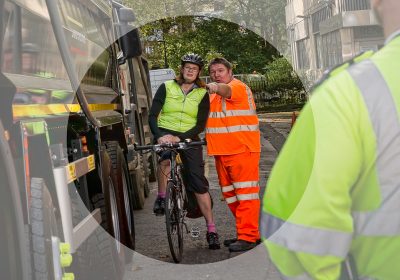Spotlight on… cycle safety aims to raise awareness of cycle safety and reduce accidents between cyclists and construction traffic...
Examples of best practice
The Scheme aims to improve the image of construction through sharing best practice with the industry. Please find below a number of best practice initiatives that have been witnessed by the Scheme’s Monitors which are designed to help construction sites minimise the risks to cyclists. These examples are just a small selection of the many initiatives that UK construction sites currently have in place to help reduce the number of cycling related accidents:
Lorry Spot Checks with Met Police
The contractor has implemented spot checks around the Regents Park Estate in collaboration with the Met Police to discourage lorries going off approved routes and keeping the roads safer for the local community. Where HS2 related lorries are using the wrong route, both teams spend time explaining the correct roads and why it was not recommended to use Regents Park…
Spotlight on… posters
Spotlight on… posters have been designed for general display in and around site welfare facilities. The Scheme has developed a collection of A3 posters from the series of ‘Spotlight on…’ learning toolkits. This resource has proven valuable for display on site and raising awareness amongst the workforce and visitors. To purchase these products, click here. To download a free electronic…
Considering Air Quality and Inclusive Design with Traffic Management Methodology
Climate change, air quality, safety and a healthy economy are at the top of the Mayor of London’s agenda and keeping London moving sustainably is the aim. Transport policies have a focus on modal shift which includes; electric fleet growth, increased use of public transport and encouraging more and safer walking and cycling will help us achieve the targets that…
Site Access Traffic Marshal Training
Site Access Traffic Marshals (SATMs) stationed at the site entrance are the primary and critical interface between the site, fleet operations and the public. They ensure only authorised vehicles and people enter the site, while also ensuring vehicles entering and leaving the site do so safely and efficiently. Competent SATMs are recognised by progressive contractors as essential members of the…
Assessing Inclusive Access during Coronavirus via Virtual Meetings using Video Technology
The pandemic has, for many of us, changed the journeys we make. As we spend more time in our local areas, active travel is a healthy, easy and convenient way of getting around for shorter journeys. It is a priority now more than ever that ‘everyone’ is able to access footways and facilities as part of their daily exercise to…
Promoting TFL’s Online Cycle Skills Course to the Workforce
Since the pandemic started the project team have taken measures to encourage the use of bicycle to travel around London, therefore having less site works using public transport. On a daily basis around 50 site workers use the projects bike store, with a large number of the workforce using Santander Cycles. Therefore, to promote safety they have been promoting TFL’s…
Sponsorship of Road Safety Scheme
The project team at Langley Grammar School have sponsored the ‘Outside your school’ Road Safety Campaign in the Slough area. The funding pays for: Campaign posters, materials and communications. Pages on multiple campaign websites. Multiple Twitter campaign announcements. Multiple Facebook campaign announcements. The campaign aims to combat the prevalence of dangerous and inappropriate driver behaviour in the vicinity of schools,…
Road User Collaboration
The project team recently had a member of the community, a London cyclist that travels past the Hackney site on a regular basis, travel in one of their HGV’s around London and the surrounding areas to show how they help to keep other road users safe. The cyclist commented: “This morning I have had the experience of sitting in the…
Cargo Bike Loading Bay Collaboration
The Mayor, through TfL, is working with London boroughs, businesses and the freight and servicing industry to reduce the adverse impacts of freight and service vehicles on the street network. The aims are to reduce the number of lorries and vans entering central London in the morning peak by 10 per cent by 2026 and incorporating cargo bikes can help…
Introducing Cargo Bikes into the Construction Industry
Cargo bikes are bicycles that have been specifically designed to carry goods of various sizes and weights. The bicycles come in a variety of forms between two, three and four wheeled custom-built frames. Many bikes are now fitted with electric pedal assist motors to help riders manage their daily activities. The Mayor, through TfL, is working with London boroughs, businesses…
Considering Alternative Cycle Routes During Works
Cycling is a fundamental element towards attaining a healthier lifestyle and benefits from the negative pollution normally associated with motor vehicles. However, there are numerous barriers to cycling especially during roadworks. For many people, lack of confidence and feelings of vulnerability are common reasons for not cycling. To encourage more cycling, Transport for London (TfL) is constructing more cycle networks….
Experiencing a Cyclist’s Perspective Using a 360 Degree Camera
The Mayor of London’s Transport Strategy, published in 2018, sets out a vision for a healthier, greener and more prosperous city. The strategy makes clear that a new type of thinking is required to increase active, efficient and sustainable travel to help achieve this vision for London. The strategy uses the ‘Healthy Streets’ approach which makes health and personal experience…
Using Signal Timings to Reduce HGV Impacts
Transport for London (TfL), London Borough of Hackney and JRL collaborated to reduce the negative impacts caused by challenging road layouts and the associated lengthy diversions for HGVs. Lorries and vans play a pivotal part in London’s economy and are a necessary part of construction. Since 2010, the movements of goods vehicles have increased by approximately 20%, which is negatively…
Concrete Pour Collaboration
This major concrete pour was successfully completed over the weekend of 29th November 2019 with minimal disruption to the network, no reported safety issues and 16 hours ahead of schedule. 533 lorries delivered 4000m3 of concrete non-stop over 31 hours from 7pm on Friday until 2am on Sunday. TfL’s Network Management Team worked meticulously with main contractor Multiplex to: Agree…
Road Safety Week with CEMEX
Ahead of National Road Safety Week, over 1,000 local school children enjoyed a day of interactive workshops and classes to teach them about staying safe as cyclists and pedestrians. The team from Southall Waterside, including representatives from Berkeley and building materials supplier CEMEX, visited three primary schools in Southall in their third annual road safety campaign. The events also marked…
Vision Zero Collaboration
Each year around 4,000 people are killed or seriously injured on London’s roads. People walking, cycling or riding motorcycles make up 80% of deaths and serious injuries on London’s roads. In July 2018, the Mayor of London, Transport for London (TfL) and the Metropolitan Police launched a bold ‘Vision Zero Action Plan’ to end the toll of deaths and serious…
Incorporating Disability Equality into Construction
Transport for London (TfL) have adopted the Healthy Streets Approach to improve air quality, reduce congestion and help make London’s diverse communities greener, healthier and more attractive places to live, work and enjoy. The vision for equality and inclusion is that every person matters in keeping London moving, working and growing. TfL also recognises the role of transport in improving…
Cycle Safety Day for University Students
Education of cyclists about their interaction with delivery lorries was taken to the next level at the cycle safety day which this site ran for the benefit of University students. Using the technology that Google use to capture information to create street view, a recording was made of a delivery vehicle’s journey from the M40 through Oxford city centre to…
Local Crash Map
In order to raise awareness of vulnerable road users and manage large-scale, just-in-time deliveries of larger steel frame elements and in-situ concrete deliveries to site in a safe manner, the site team have developed an innovative ‘crash map’. This map draws on information captured from Transport Scotland’s database, to alert and highlight the numerous major traffic accident black-spots leading into…
Considering Disabled Cyclists and Bespoke Cycles at Roadworks
Londoners are facing the same health challenges as people across the UK with ‘lifestyle’ diseases such as diabetes, obesity and heart disease on the rise. Such conditions can take a toll on health and life expectancy. A leading cause of illness and early death among Londoners today is physical inactivity. Transport can play a significant role in enabling people to…
Crushing Concrete on Site
London is in breach of European legal limits for Nitrogen Dioxide (NO2), and many areas exceed the safe limits for Particulate Matter (PM) set by the World Health Organisation (WHO). Pollution is a contributing factor in shortening the life expectancy of Londoners and disproportionately impacts the most vulnerable. Approximately 9,500 deaths occur each year due to the illnesses caused by…
A Constructor’s Cycle Experience
Transport for London (TfL) have adopted the Healthy Streets Approach to help make London’s diverse communities greener, healthier and more attractive places to live, work, play and do business. Part of the Healthy Streets approach is to encourage more walking, cycling and use of public transport. To maintain these aspirations we require assistance from all our partners and stakeholders. London’s…
Cycle Safety: A Virtual Reality Experience
We work closely with the Metropolitan Police and their Exchanging Places cycle safety programme. Due to our great working relationship, the Met Police Cycle Safety Team asked for our assistance with a trial of their new virtual reality Exchanging Places program and we were happy to help. The trial consisted of a short presentation and a 3D video delivered in…
Virtual Reality Hazard Perception Presentation
Community safety should be at the heart of a considerate construction project. Cycle safety is a key element of community safety, and sites should seek to raise awareness of this topic among the public and their workforce. See the examples below for how one site addressed this: The site acknowledged there was a large number of cyclists both commuting to…
CLOCS Compliance Checks
Construction Logistics and Community Safety (CLOCS) is a national standard which brings together the construction logistics industry to revolutionise the management of Work Related Road Risk (WRRR) and embed a road safety culture across the industry. The CLOCS Standard calls for the construction industry to recognise its responsibilities for vehicles and drivers delivering to and collecting from construction sites. The Considerate Constructors…
Loading Design Guidance
In 2014-15, HGVs were involved in 25% of pedestrian fatalities and 60% of cyclist fatalities. The long term impacts from Nitrogen Dioxide (NO2) and Particulate Matter (PM10), of which a large proportion comes from HGVs, are the cause for over 9,000 deaths each year in London. Negative impacts can often occur when loading facilities are either poorly designed or can…
Cyclists and Vehicle Drivers Learning From Each Other
Knowing how important cycling is in Walthamstow with the Mini Holland cycling infrastructure scheme, when we started a new project in Walthamstow, not far from Blackhorse Road tube station, we decided that we would do a road safety event to show local cyclists we are considerate to them but also allow them to have the chance to sit in one…


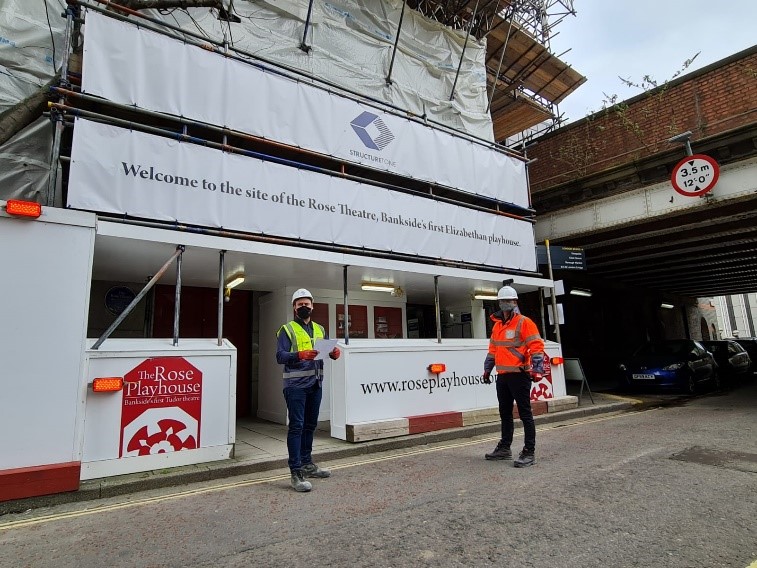
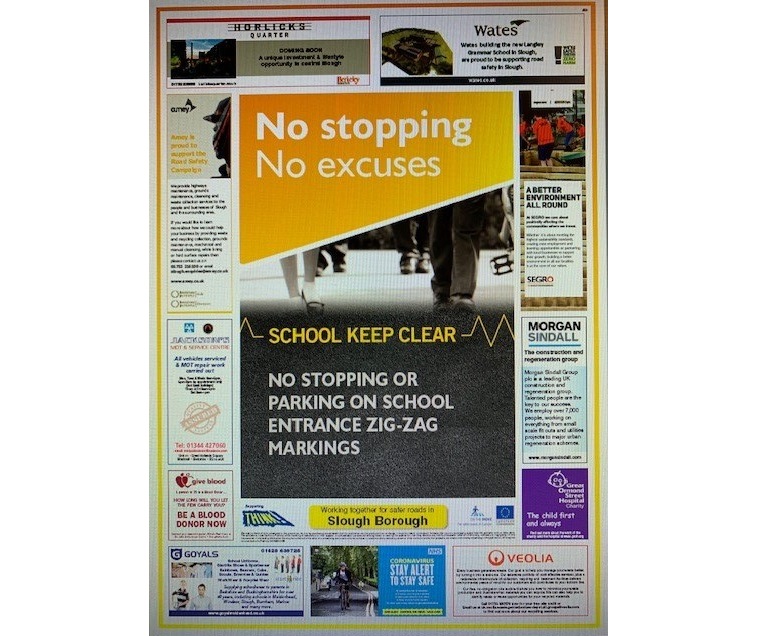

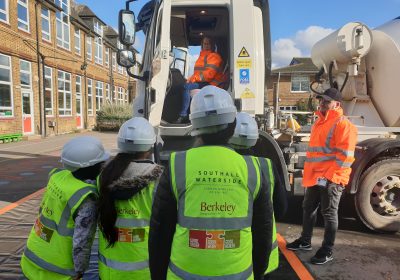
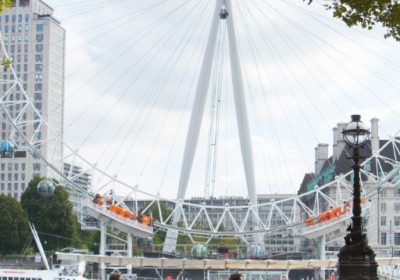

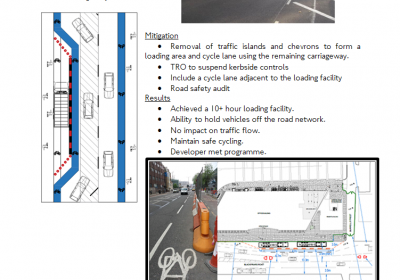

 Longcross Construction’s Castle Mill site supported their community through promoting the use of bicycles to operatives and put in place a safety measure to protect the public. To find out more, click
Longcross Construction’s Castle Mill site supported their community through promoting the use of bicycles to operatives and put in place a safety measure to protect the public. To find out more, click 









